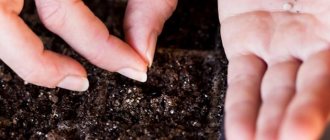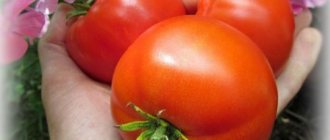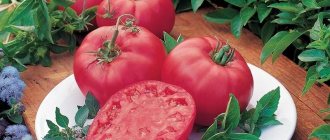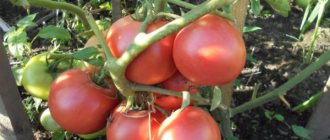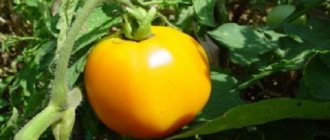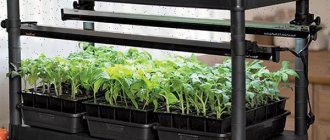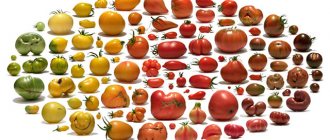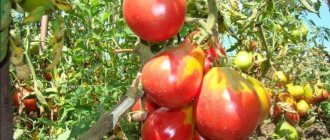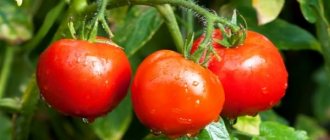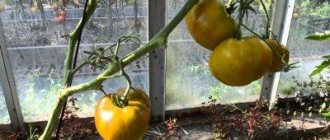Agrobiotechnicians know very well what all farmers dream of. Breeders have embodied high productivity, excellent taste, presentability and marketability in the elite tomato Gardener's Dream. The hybrid variety is not capricious and bears fruit consistently in different climatic zones.
| Height | Landing location | Ripening time | Fruit color | Fruit size | Origin | Fruit shape |
| short | Greenhouse, Open ground | Early ripening | Reds | Average | Hybrid | Round |
general information
This tomato was bred by Russian breeders. The characteristics and description of the variety indicate that its purpose is to grow in film-coated or glazed greenhouses in open areas.
Tomatoes of the Gardener's Dream variety have low bushes (determinate). Ripening begins quite early, so these tomatoes are the dream of any gardener. The growing season is only 95 to 100 days.
The height of a tomato bush can reach approximately 60 – 70 cm. The foliage is average. The ovary is formed on brushes of 4–6 pieces. One bush can have up to 5 brushes. With proper care of the plant from 1 sq. m you can harvest up to 6.8 kg of tomatoes. The harvested crop is well stored and does not deteriorate during transportation.
The fruits of this tomato variety have a rounded-flattened shape. The surface is smooth, glossy without pronounced ribbing. As tomatoes ripen, they acquire a bright scarlet hue. The average weight of one tomato is 180 g. Tomato pulp has a pleasant taste, moderately dense and juicy consistency. The peculiarities of taste are due to the increased content of sugar and lycopene. In a tomato, most of the volume is occupied by seed chambers.
Tomatoes of the Gardener's Dream variety are consumed fresh, prepared in salads, sauces, and added to soups. Ripe tomatoes are used to make juices.
Tomato Lazy Dream - description and characteristics of the variety
Passage variety
Little is known about the creation of this variety. Someone was bred in the first years of this century by breeders working in our country. Made in 2008, the necessary tests were carried out. After this, the variety was given the name Summer Dream. It was entered into the state register.
General playback
First of all, it must be said that Summer Dream is a new variety in comparison. He is not a hybrid. There are no prefix hybrids of the same name. Tomato bushes of this variety are standard and determinate. As a rule, the height of the plant is 35-40 cm. Already 3 months after the seedlings have sprouted, the first annona can be collected. Therefore, the variety is considered early.
The leaves on the bushes are quite long and have an average width. They have a transparent emerald tint. Shoots on the bushes of the Summer Dream variety do not need to be pinched.
Simple inflorescences form on the plant. When ripe, the fruits have a delicate American ruble hue. And when they are ripe, they acquire a bright garnet color. Tomatoes have a slightly ribbed, flat-round shape. Each cherry plum contains at least 4 nests in which the seeds are located.
The heart is important) that the variety is not a hybrid. Therefore, the seeds are suitable for planting a second time
The fruits grow medium in size and weigh an average of 125 g. The variety is one of those that gives an average harvest. About 4.8 kg of tomatoes per 1 square meter are collected from the ceiling.
But plants of this variety have an undeniable advantage. They are resistant to many major diseases. Little: illiterate are afraid of such typical tomato diseases as powdery sludge, fusarium, tobacco mosaic. They also do not suffer from verticillium and late blight.
As a rule, tomatoes of this variety are grown in greenhouses or under film.
Perfections and flaws
The popularity of the variety is due to the fact that it has a lot of preference compared to many others. Let's look at his main virtues.
- The bushes are very resistant to most diseases that often affect the buttocks. This allows you to preserve plants longer and get a larger harvest. Moreover, the need for processing is reduced, saving time and money.
- The harvest ripens early and quite well.
- You can significantly save on processing, since there is no need to tie up or pinch the bushes. They are unimportant (\u003d unimportant) require the removal of stepchildren.
- The plants are small in size.
- The fruits have excellent taste and will retain their presentation for a century.
- Suitable for growing for sale, c) to the extent that they do not deteriorate during transportation.
- The skin does not crack.
- There is no need to buy seeds every year because they are good enough. Ant. cannot be used for sowing.
The variety has almost no disadvantages. This is what makes it so popular.
How to grow
Based on the experience of gardeners, to grow Summer Dream tomatoes you must first grow seedlings. And sooner or later the plants get stronger, they are planted in a greenhouse.
To grow seedlings, take a plunger container and plant the seeds in the prepared substrate. This can be done now in mid-January. But it is entirely permissible to begin sowing until the very end of Martha.
It is recommended to sow seeds and care for seedlings in the same way as in the case of other varieties. It is recommended to place a fluorescent lamp above the box. This is necessary so that transfers are not delayed due to the short daylight hours. Under the light of the lamp, the seedlings will not stretch. The plant will develop strong.
To avoid the need for a dive, it is recommended to place the super-elite more sparingly. After sowing, seedlings will appear within 7-10 days. Containers should be kept in a room where the temperature is maintained at about 15 degrees.
Before planting tomatoes in a greenhouse, it is recommended to feed them several times using complex fields). Watering should be moderate. After April 10, you can start planting bushes in the greenhouse. Moreover, depending on whether you planted seedlings, the harvest is harvested at different times. This century falls on June-September.
Gardeners who have already tried this variety note that it is easy to care for. It is only necessary to carry out timely watering, loosen the soil, remove weeds and apply fertilizing several times over the summer.
Growing rules
The process of planting tomato seeds of the Gardener's Dream variety to obtain seedlings begins in the second half of March. Immediately before sowing, the seeds of the variety are treated with a special growth stimulator. This ensures rapid germination and enhances plant immunity.
Soil consisting of compost, turf soil and river sand is poured into containers prepared for planting. To disinfect the soil, it is calcined in the oven or generously watered with a low concentration solution of potassium permanganate.
The temperature of the room in which the containers with germinated seeds will be located should be about +23 degrees. The container is covered with film or glass. Only after seed germination and the appearance of the first shoots, the temperature is lowered by 2 - 3 degrees, and the containers are placed in such a way as to provide access to sunlight for 12 - 14 hours. The container cover must be removed.
Harvest
One of the advantages of this variety is its rapid ripening. Already at the end of June you can begin to harvest. The weight of each tomato is 140–180 g. The fruits are bright red, round, with a glossy skin.
The pulp is juicy, but not watery. The taste is sweet. The variety is ideal for fresh consumption and in hot vegetable dishes . Often used for processing. Tomatoes are rich in vitamins and lycopene. This substance is a powerful antioxidant and immunostimulant. During heat treatment, its content in fruits becomes more concentrated.
Seedling lighting
If natural light is insufficient, additional lighting is provided with fluorescent lamps to stimulate photosynthesis. It is impossible to carry out illumination throughout the day without interruption, since necessary biological processes also occur in the dark.
At this time, watering the tomatoes is carried out using a watering can, settled with heated water. After the first true leaves appear, the seedlings are planted and the first fertilizing is carried out with mineral complex fertilizers.
2 weeks before planting seedlings in the ground, they are hardened off. To do this, pots with tomato seedlings are taken out into the open air.
How to grow tomatoes
After 2 months, the seedlings are ready for transplanting. They are planted in a greenhouse in early May, and under film covers 1-2 weeks later, when the soil warms up to 17 °C.
Landing
The soil is dug up with humus added and shallow holes are made, at the bottom of which 1 tablespoon of superphosphate or wood ash is placed. The holes are filled with warm water.
Planting pattern: 40 cm – distance between seedlings, 60 cm – row spacing. For 1 sq. m place no more than 4 plants.
After transplantation, the holes are compacted, moderately watered with warm water and the young bushes are left to get used to the new conditions.
Further care
Regular watering is established as the seedlings take root. Water 2 times a week with settled water at the root of the plants. To keep moisture in the beds longer, they are mulched with peat or straw. After watering, the soil is loosened and weeds with roots are removed.
The danger of weed growth is that they take from the soil a large amount of nutrients necessary for the development of tomatoes. In addition, pathogenic spores and pests multiply in weeds.
Fertilizing is applied 3-4 times per season. They are fed with fertilizers containing phosphorus and potassium substances, alternating them with organic matter.
During flowering, they are fertilized with a mineral complex with a high content of phosphorus elements, and during fruiting, potassium fertilizers are applied.
From organic matter, use mullein infusion or bird droppings at a dilution of 1:15.
Features of care and possible difficulties
Despite the determinant type, plants require staking and pinching. Not only the stem, but also the fruit-bearing branches are tied to vertical or horizontal supports. When transplanting, wooden stakes or metal rods are installed next to each bush, to which the plant is fixed.
As for the horizontal support, this is the most practical fixation option. From different sides of the beds, a wire is pulled between metal supports and the branches are fixed to the wire with soft fabric tapes. A garter on a trellis makes harvesting easier.
The formation of a culture is necessary for a full harvest. The plant is formed into 1 or 2 stems, removing all lateral shoots. They take stepsons early in the morning so that by the evening all the wounds have time to heal. The cut areas are sprinkled with ash to prevent infection.
Diseases and pests
In greenhouse conditions, the likelihood of infection by fungal diseases increases. This is due to the fact that protected structures often experience elevated temperatures and humidity levels. Although the culture has proven itself to be highly resistant to such infections, it is recommended that preventive measures be followed without fail.
Prevention includes moderate watering, systematic loosening and mandatory daily ventilation. Compliance with the rules of crop rotation helps strengthen plant immunity.
Before planting, the soil is spilled with a solution of manganese and treated with copper sulfate, which kills fungal spores.
Among the pests that are dangerous for tomatoes are spider mites, aphids, mole crickets and slugs. Treatment with soapy water or ammonia can help prevent slugs and aphids. To scare away the mole cricket from the beds, just plant onions next to the tomatoes or dig crushed cloves of garlic into the soil. The mole cricket is dangerous because it moves underground and is difficult to notice. Therefore, experienced summer residents do not wait until the insect damages the root system, and immediately after planting in the ground they take the necessary measures.
As for the Colorado potato beetle, it is collected by hand, carefully inspecting each seedling from all sides. When there is a large concentration of the pest, the drug “Prestige” is used.
Planting seedlings in the soil
Transplanting into a greenhouse begins in early May, and replanting them under film takes place a little later. It is necessary to ensure that the soil at the time of planting has a temperature of at least 14 degrees at a 15-centimeter depth. Seedlings are planted in areas where onions, parsley, zucchini, carrots, and cucumbers previously grew.
Experienced gardeners advise adding wood ash and superphosphate (1 tbsp) to each hole. Tomatoes of this variety are planted in the ground so that their number per 1 sq. m did not exceed 4 plants.
See also
Characteristics and description of the Tolstushka tomato variety, its yieldRead
Although the bushes of the variety are not tall, they have quite a lot of stems, so pinching is required. The stepsons break off when their size reaches approximately 4 cm. Usually for 1 tomato bush it is enough to leave 1 - 2 main stems, the rest must be removed in a timely manner.
Farmer reviews
Based on the positive reviews of those who planted the crop in their garden, one can judge its popularity. Here are some opinions:
Ksenia, Taganrog: “I planted it for the first time 2 years ago on the advice of a friend. She spent practically no effort or time on care. The plants have formed strong and powerful. I picked my first tomatoes at the end of June and immediately fell in love with their taste. That’s when I realized: I won’t plant any large varieties.”
Margarita, Syzran: “I love this tomato for its ease of care and the unusual taste of ripe vegetables. I've been planting them for years and am always happy with the results. The variety does not get sick, does not require special attention - this is exactly what I need. I use the fruits not only for summer salads, but also make juices from them for the winter.”
Irrigation mode
Watering is carried out as the soil dries. Excessive watering with stagnant water is harmful to tomatoes. This can lead to rotting of the root system of the bush.
During the ripening of tomatoes, watering is limited so that sugar is formed in the fruits and the tomatoes have a richer taste.
During the season, the plant is fed 3–4 times. Phosphate and potassium fertilizers are required.
Nuances when growing tomatoes
Despite the low growth of seedlings, you should not thicken the plantings too much.
When the plants are crowded, they suffer from a lack of light, which leads to negative consequences. In addition, the bushes are not ventilated, which causes diseases. The lower leaves up to the first fruitful branch must be removed so that they do not come into contact with wet beds. Otherwise, the leaves will rot and the plant will become sick.
When growing any crop in a greenhouse, it is best to use drip irrigation. This eliminates many additional difficulties, including high levels of humidity in the beds. For drip irrigation, place a regular plastic bottle without a bottom, neck down, and fill it with water. From it, moisture gradually flows to the root system.
We fight diseases and insect pests
Tomatoes of the Gardener's Dream variety are quite resistant to the occurrence of typical diseases (fusarium, crown and root rot). Early ripening of fruits on bushes ensures resistance to late blight. If there is a risk of late blight infection, spraying with preparations containing copper is carried out.
For the purpose of prevention, bushes of the Gardener's Dream variety are treated with Fitosporin or other similar non-toxic drugs in the amount required by their description. It is necessary to follow the watering regime, remove weeds, and in greenhouse conditions, be sure to ventilate the room to remove high air humidity and minimize the risk of developing fungal diseases. Weekly loosening of row spacing is required.
To cope with possible pests of tomatoes (spider mites, naked slugs, mole crickets, aphids, whiteflies, thrips), the soil is mulched and weeded. The bushes are constantly inspected, and if signs of pest damage are found, they are sprayed with insecticides. According to the experience of gardeners , repeated treatment with such preparations is mandatory.
You can get rid of aphids on the bushes with a soap solution sprinkled on the planted tomato bushes. Slugs are afraid of spraying with water containing ammonia.
Tomato Lazy Dream - description and characteristics of the variety
Passage variety
Little is known about the creation of this variety. Someone was bred in the first years of this century by breeders working in our country. Made in 2008, the necessary tests were carried out. After this, the variety was given the name Summer Dream. It was entered into the state register.
General playback
First of all, it must be said that Summer Dream is a new variety in comparison. He is not a hybrid. There are no prefix hybrids of the same name. Tomato bushes of this variety are standard and determinate. As a rule, the height of the plant is 35-40 cm. Already 3 months after the seedlings have sprouted, the first annona can be collected. Therefore, the variety is considered early.
The leaves on the bushes are quite long and have an average width. They have a transparent emerald tint. Shoots on the bushes of the Summer Dream variety do not need to be pinched.
Simple inflorescences form on the plant. When ripe, the fruits have a delicate American ruble hue. And when they are ripe, they acquire a bright garnet color. Tomatoes have a slightly ribbed, flat-round shape. Each cherry plum contains at least 4 nests in which the seeds are located.
The heart is important) that the variety is not a hybrid. Therefore, the seeds are suitable for planting a second time
The fruits grow medium in size and weigh an average of 125 g. The variety is one of those that gives an average harvest. About 4.8 kg of tomatoes per 1 square meter are collected from the ceiling.
But plants of this variety have an undeniable advantage. They are resistant to many major diseases. Little: illiterate are afraid of such typical tomato diseases as powdery sludge, fusarium, tobacco mosaic. They also do not suffer from verticillium and late blight.
As a rule, tomatoes of this variety are grown in greenhouses or under film.
Perfections and flaws
The popularity of the variety is due to the fact that it has a lot of preference compared to many others. Let's look at his main virtues.
- The bushes are very resistant to most diseases that often affect the buttocks. This allows you to preserve plants longer and get a larger harvest. Moreover, the need for processing is reduced, saving time and money.
- The harvest ripens early and quite well.
- You can significantly save on processing, since there is no need to tie up or pinch the bushes. They are unimportant (\u003d unimportant) require the removal of stepchildren.
- The plants are small in size.
- The fruits have excellent taste and will retain their presentation for a century.
- Suitable for growing for sale, c) to the extent that they do not deteriorate during transportation.
- The skin does not crack.
- There is no need to buy seeds every year because they are good enough. Ant. cannot be used for sowing.
The variety has almost no disadvantages. This is what makes it so popular.
How to grow
Based on the experience of gardeners, to grow Summer Dream tomatoes you must first grow seedlings. And sooner or later the plants get stronger, they are planted in a greenhouse.
To grow seedlings, take a plunger container and plant the seeds in the prepared substrate. This can be done now in mid-January. But it is entirely permissible to begin sowing until the very end of Martha.
It is recommended to sow seeds and care for seedlings in the same way as in the case of other varieties. It is recommended to place a fluorescent lamp above the box. This is necessary so that transfers are not delayed due to the short daylight hours. Under the light of the lamp, the seedlings will not stretch. The plant will develop strong.
To avoid the need for a dive, it is recommended to place the super-elite more sparingly. After sowing, seedlings will appear within 7-10 days. Containers should be kept in a room where the temperature is maintained at about 15 degrees.
Before planting tomatoes in a greenhouse, it is recommended to feed them several times using complex fields). Watering should be moderate. After April 10, you can start planting bushes in the greenhouse. Moreover, depending on whether you planted seedlings, the harvest is harvested at different times. This century falls on June-September.
Gardeners who have already tried this variety note that it is easy to care for. It is only necessary to carry out timely watering, loosen the soil, remove weeds and apply fertilizing several times over the summer.
